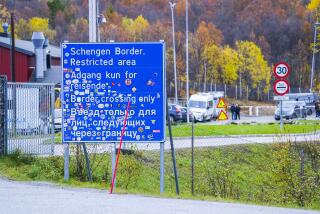Cracking Open a Cold Passage to Alaska
- Share via
OSLO — Norwegian scientists are exploring the possibility of a year-round route through the frozen ocean north of Siberia that could change the way the world does business.
Unlike their Viking ancestors, who braved unknown seas in wooden ships, these modern adventurers search from laboratories, with computers and calculators.
Oslo’s Fridtjof Nansen Institute, named for the Norwegian explorer, was enlisted by the Soviet Merchant Marine Ministry to explore the feasibility of opening the Northeast Passage all year.
The Soviets envision huge icebreakers leading merchant ships through the polar ice pack like outsize ducklings trailing their mother.
Willy Oestreng, director of the institute, said the 4,000-mile passage north of the Soviet Union is the shortest route between Europe and the Far East, about half the distance through the Suez or Panama canals.
“It could revolutionize world shipping,” he said. The study began formally at the end of October, after two years of discussion.
Adolf Erik Nordenskiold, a Finnish-Swedish explorer and scientist, first negotiated the ice-congested passage between northern Norway and Alaska in a daring two-year steamship voyage that ended in 1879.
A combination of ice ridges 42 feet thick, bitter cold, four months of winter nights and Soviet strategic concerns have prevented the shortcut, often called the Northern Sea Route, from becoming an important factor in world trade.
Oestreng said changes in the Soviet Union and the raw power of modern icebreakers had helped overcome the obstacles.
He said the Soviets believe that their icebreakers, which now clear the passage from July to October for the Soviet coastal trade, might be able to open it all year.
Soviet officials hope the route will generate hard currency from fees paid to use the passage and hire Soviet ships, and stimulate the economy of isolated Siberia and the Arctic coast, Oestreng said.
Norwegian and outside experts will study the technological challenges, costs, legal and political questions, and the environmental impact of keeping the passage open, Oestreng said. He added that the eight-month pilot project would “define the state of the art” of Arctic navigation.
“The main questions are commerciality and the environment,” he said, and further research will be required if the pilot project is encouraging, but “if everything fell into place, it could be open in a decade.”
His institute, which has specialists in polar research, raised $200,000 for the study from various Norwegian sources.
“The Soviets had nothing to pay with . . . and Norway, as a traditional shipping nation, has to get in on this,” Oestreng explained.
Scientists and environmentalists are concerned about the threat of oil spills or nuclear accidents.
“We would be opposed to using nuclear icebreakers to keep the passage open,” said Steve Shallhorn, a Greenpeace activist from Canada, who toured a Soviet icebreaker base in the Arctic on Sept. 24.
Shuttle traffic of nuclear icebreakers or oil-laden tankers could threaten the Arctic’s fragile ecology, Shallhorn said.
Environmental concerns arising from the Exxon Valdez oil spill in Alaska may make the Northeast Passage commercially viable 111 years after it was discovered.
Some oil tankers are being ordered with double hulls, a feature intended to prevent oil spills, and “that would go far toward the requirements of arctic conditions,” said Arnfinn Jorgensen-Dahl of the Nansen Institute.
He said the thick-hulled ships needed to endure the ice of the Northeast Passage once were deemed too expensive, but “now, concern for the environment may be about to even out prices between vessels built for Arctic and non-Arctic waters.”
Oestreng emphasized that the Arctic is a harsh place, and cautioned the overly optimistic: “We’d better not sell the skin before the bear’s been shot.”
More to Read
Sign up for Essential California
The most important California stories and recommendations in your inbox every morning.
You may occasionally receive promotional content from the Los Angeles Times.











